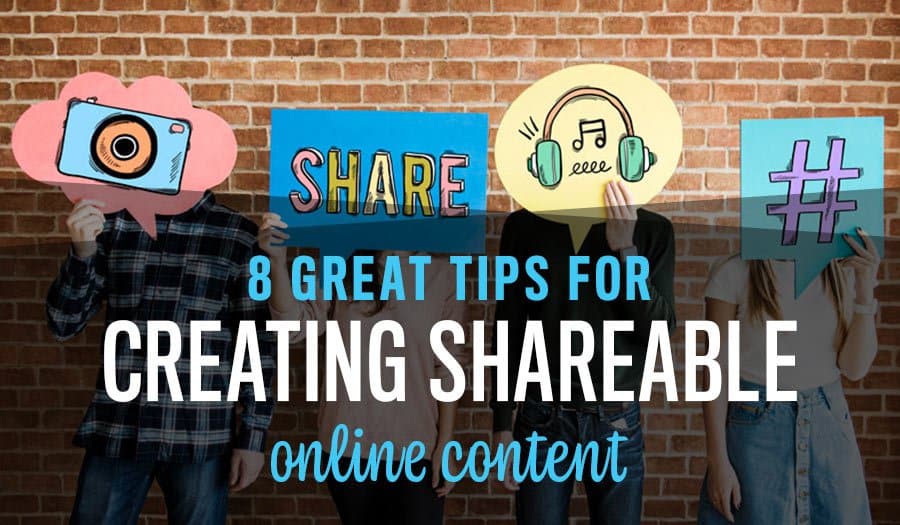Shareable content engages your audience and moves them to share it amongst their network. Once upon a time, this was limited to forwarding an email. Today, with social media at our fingertips, sharing content with hundreds – and often thousands – of people with one or two clicks is quick and easy. Here are 8 Great Tips for Creating Shareable Content.
Your marketing strategy should include creating actionable, likeable and engaging content that delivers a great experience to your audience.
Exactly what is shareable content?
What one person deems shareable content, may not appeal to another, however shareable content will generally be:
- relevant,
- relatable,
- authentic,
- of value to the audience,
- spark interest, and
- evoke emotion.
Shareable content delivers what the audience wants. Content with the highest engagement will therefore be contingent on the specific audience you are targeting.
The Keys to Creating shareable content
Shareable content is usually carefully considered in its creation. Even the most amazing content piece is unlikely to be shared unless it is optimised for social media and created mindful of social-specific objectives.
Here are some questions to ask yourself as you begin to create shareable content, to help you hone your focus:
- What is the goal of your content?
- Does your content tell – or sell?
- Is your content relevant?
- Is your content informative?
- Will your audience find your content usable and/or valuable?
- Is your content engaging?
- Does your content move your audience? If so, how will it make your audience feel?
- Does your content include a call-to-action?
- Will your content catch your audience’s attention?
- Will your content keep your audience’s attention?
A great way to create content that will check all the right boxes is to learn what interests your target audience.
8 Great Ways to create exciting & useful content
- Find a hook
- Make sharing easy
- Create what is already working
- Choose your medium
- Measure your success
- Content driven headlines
- Find your voice
- Do a Content review
Spend some time researching what your audience is already sharing, what content they enjoy and what content they are already interacting with.
When you have discovered exactly what interests your audience and what they are searching for, you can create interesting and useful content tailored specifically to reach this target audience.
If your content solves your audience’s problem, you have created shareable content. Whilst your audience may not be willing to share a blatant advertisement with their friends, they will certainly want to share a solution to a common problem with them.
When you create content that illustrates your audience’s concern and then answer that concern with a solution, you have winning content to promote widely.
1. Find a hook
Humourous and/or entertaining content can increase your chances of having your content shared. After all, humourous content easily gets an audience reaction and has a greater chance of going viral.
If you can make educational content light, witty and funny, you will be on your way to engaging your audience and garnering those likes and shares.
Shareworthy content will frequently use humour, excitement, fear, sadness or curiosity to hook the reader in and will often play on their emotions. If you can find a way to connect to your audience on an emotional level, you will most likely guarantee yourself more shares!
2. Make sharing easy
Make it easy to share your content with easy-to-find, well-designed social sharing buttons. WordPress have a great plug-in for this exact purpose: the Sharebar. The Sharebar is a vertical bar that is fully customizable, containing links/buttons to all the top social media platforms such as Facebook, Twitter, Pinterest, Stumbleupon, Reddit and Email.
Check that your website’s share buttons are easy to see no matter what device or platform your audience is viewing your content on.
It should go without saying, but if you want to drive traffic to your website, your content simply must be optimised for mobile viewing – after all, in 2018, 52.2 per cent of all website traffic globally was generated through mobile phones. In Asia, visits to websites generated through mobile phones made up 65.1 per cent of all website traffic, as noted in early 2017.
3. Create what is already working
Bite-size (or snackable) content is likely to be shared more, such as lists and multimedia content, such as GIFs, videos and posts with attention-grabbing graphics. If you’re not up to creating multi-media content yourself, start with bite-size content and always include an image (more about that below).
4. Choose your medium
The medium you share your content to will also impact how much it is shared. Facebook users share images more than any other post type and receive more attention. Images posted to Facebook receive 53 percent more likes, 84 percent more click-through and 104 percent more comments than a post without an image.
Different content is popular on different social platforms. Learn what works best for each platform, and create the right content for that medium.
5. Measure your success
Of course, we’d all love to create a viral post every single time, but having realistic, achievable goals is an important way for you to be able to measure your content’s success effectively, so be pragmatic with your ambitions.
We all hope our content produces a massive increase in website visitors, results in a massive increase in our revenue and collects thousands of likes, shares and retweets along the way! Starting with realistic and achievable goals, however, will help you to accurately measure your content’s success.
Some examples of goals you may aim for within a set time period are:
- Increase in Instagram likes of X
- Increase in Facebook likes of X
- Increase in retweets on Twitter of X
- Increase in shares on LinkedIn of X
- X amount of social media mentions
- X number of downloads
- X% increase in web traffic directly from social media
As long as your goals are attainable, reasonable and possible (based on analytics data), precisely defined goals allow you to track and measure exactly what is working for your audience.
6. Content driven headlines
Your headlines are often the first thing your audience will see, so they need to earn their click straight away.
Your headline is a critical part of the success of your content. If your headline cannot grab your potential audience’s attention, it is unlikely you will get your click, like or share.
Here are some tips on how to craft an attention-grabbing headline:
- Use keywords in your headline to stir up interest and ensure you appear in relevant searches
- Use numbers, such as “5 Facts About Fitness You Can’t Ignore”
- Include the year, if relevant, such as “Digital Marketing in 2019”
- If your post is a ‘how-to’, say so in the title
- Don’t be afraid to use click-bait! Use controversial headlines, such as “How posting to little – or too much- can ruin your business!” or “The biggest mistake e-commerce stores are making now!”
7. Find your voice
Social networking is, well, social! Your tone should be conversational, genuine and natural. When you create content remember to be yourself. Your readers will pick up on your authenticity, which will make it easier for them to relate to your message.
8. Do a Content review
When it comes time to review your content, consider these five points:
- Is it targeted? You want your audience to take action. Have you included the right hashtags and/or a call-to-action to encourage your audience to interact with your content?
- Will it evoke emotion? How will your content make your audience feel?
- Is your content optimised for success? Is your content’s design optimised for shares? Have you made it easy for your content to be shared?
- Is your content relevant? Is your content relevant to your audience and relevant to the products/services your business provides?
- Did you proofread? So many fantastic posts are let down by poor spelling and grammar. Failing to proofread can hurt you in many ways: it undermines the authority of your post; illustrates poor attention to detail and, possibly worst of all, badly written content ultimately hurts your share-ability.
Social media platforms such as Instagram, Facebook and Twitter allow users to express who they are, and part of how they do that is through the content they share.
People may not be lining up to fill their followers’ feeds with posts advertising your products and services. However, they may do exactly that if your content informs them, uplifts them, helps them or adds value in some way.
If you want help creating clever content, or if your website is struggling to convert your visitors, it’s never too late to seek expert advice. With over 10 years of experience, Pixel Fish is renowned for creating engaging websites that convert!
Take that next step and get in touch with Pixel Fish. We can arrange a time to sit down with you for a website planning session to gain a clear idea of the look and feel you envisage for your website and get you on the path to success!
Let Sydney’s leading Web Design Agency take your business to the next level with a Pixel Fish Small Business Website.



